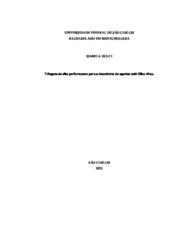| dc.contributor.author | Dolci, Isabela | |
| dc.date.accessioned | 2022-05-04T22:07:45Z | |
| dc.date.available | 2022-05-04T22:07:45Z | |
| dc.date.issued | 2022-04-13 | |
| dc.identifier.citation | DOLCI, Isabela. Triagens de alta performance para a descoberta de agentes anti-Zika vírus. 2022. Trabalho de Conclusão de Curso (Graduação em Biotecnologia) – Universidade Federal de São Carlos, São Carlos, 2022. Disponível em: https://repositorio.ufscar.br/handle/ufscar/16024. | * |
| dc.identifier.uri | https://repositorio.ufscar.br/handle/ufscar/16024 | |
| dc.description.abstract | The Zika virus (ZIKV) is an mosquito-borne transmitted by the bite of the Aedes aegypti mosquito, which became a public health problem during the 2015/2016 outbreak in the Americas and mainly in Brazil, where it was related to cases of microcephaly and Guillan syndrome. -Barré. The potential of the virus to re-emerge causing new epidemics is always latent, therefore, the search for effective treatments against viral infection becomes necessary, since there are still no vaccines or drugs available. The identification of antiviral agents quickly and efficiently depends on cellular/biochemical assays that can be performed in a high-throughput screening (HTS) mode. In this work, we used two HTS screening strategies to identify anti-ZIKV molecules. The first strategy was phenotypic, using cell assays based on replicon, a system in which the viral genome is modified by replacing structural proteins with a reporter gene. Thereby, there is no formation of new infecting viral particles, but the replication complex is kept fully functional. This approach was used to evaluate 560 molecules, among which 4 were able to inhibit the replication of the replicon, with Remdesivir being the most promising due to its high selectivity index (IS = 88.6). The second strategy was target-based and consisted of using the recombinant ZIKV protease, NS2B-NS3, expressed in bacteria and purified in 3 steps, to evaluate 4576 molecules in enzyme activity assays, which allowed the identification of 7 compounds capable of inhibit the enzyme by more than 80%. Both strategies proved to be very efficient for the proposed objectives, contributing to the advance in the search for potential anti-ZIKV agents. The next steps will be the confirmation of the inhibition of viral replication by the 4 compounds resulting from the phenotypic screening by quantification of the RNA replicon, using qRT-PCR, and also through viral infection assays through collaboration with Prof. Ana Carolina Jardim from the Federal University of Uberlandia (UFU). Regarding the compounds identified in the enzymatic assays, these will be validated in the cellular model expressing the ZIKV replicon. | eng |
| dc.description.sponsorship | Fundação de Amparo à Pesquisa do Estado de São Paulo (FAPESP) | por |
| dc.language.iso | por | por |
| dc.publisher | Universidade Federal de São Carlos | por |
| dc.rights | Attribution-NonCommercial-NoDerivs 3.0 Brazil | * |
| dc.rights.uri | http://creativecommons.org/licenses/by-nc-nd/3.0/br/ | * |
| dc.subject | Flavivírus | por |
| dc.subject | Zika | por |
| dc.subject | Drogas | por |
| dc.subject | Virus | por |
| dc.subject | NS2B | eng |
| dc.subject | NS3 | eng |
| dc.subject | Enzymatic | eng |
| dc.subject | Replicon | eng |
| dc.title | Triagens de alta performance para a descoberta de agentes anti-Zika vírus | por |
| dc.title.alternative | High-throughput screening for discovery of anti-Zika virus agents | eng |
| dc.type | TCC | por |
| dc.contributor.advisor1 | Sachetto, Rafaela Fernandes | |
| dc.contributor.advisor1Lattes | http://lattes.cnpq.br/2580624711278661 | por |
| dc.contributor.advisor-co1 | Fuentes, Andrea Soares da Costa | |
| dc.contributor.advisor-co1Lattes | http://lattes.cnpq.br/2426157257540389 | por |
| dc.description.resumo | O Zika vírus (ZIKV) é um arbovírus transmitido pela picada do mosquito Aedes aegypti, que se tornou um problema de saúde pública durante o surto de 2015/2016 nas Américas e principalmente no Brasil, onde foi relacionado aos casos de microcefalia e síndrome de Guillan-Barré. O potencial do vírus em reemergir causando novas epidemias é sempre latente, portanto, a busca por tratamentos efetivos contra a infecção viral se torna necessária, visto que ainda não existem vacinas ou fármacos disponíveis. A identificação de agentes antivirais de forma rápida e eficiente depende de ensaios celulares/bioquímicos que possam ser realizados em modo de triagem de alta performance (high-throughput screening, HTS). Neste trabalho, utilizamos duas estratégias de triagem HTS para identificar moléculas anti-ZIKV. A primeira estratégia foi fenotípica, utilizando ensaios celulares baseados em replicon, sistema no qual o genoma viral é modificado substituindo-se as proteínas estruturais por um gene repórter. Dessa forma, não há formação de novas partículas virais infectantes, mas o complexo de replicação é mantido totalmente funcional. Esta abordagem foi utilizada para avaliar 560 moléculas, dentre as quais, 4 foram capazes de inibir a replicação do replicon, sendo o Remdesivir a mais promissora devido ao seu alto índice de seletividade (IS = 88,6). A segunda estratégia foi baseada em alvo e consistiu em utilizar a protease recombinante de ZIKV, NS2B-NS3, expressa em bactérias e purificada em 3 etapas, para avaliar 4576 moléculas em ensaios de atividade enzimática, o que possibilitou a identificação de 7 compostos capazes de inibir a enzima em mais de 80%. Ambas as estratégias se mostraram muito eficientes para os objetivos propostos, contribuindo para o avanço na busca de potenciais agentes anti-ZIKV. Os próximos passos serão a confirmação da inibição da replicação viral pelos 4 compostos resultantes da triagem fenotípica por quantificação do RNA replicon, utilizando qRT-PCR, e também através de ensaios de infecção viral por meio de colaboração com a Prof. Ana Carolina Jardim da Universidade Federal de Uberlandia (UFU). Em relação os compostos identificados nos ensaios enzimáticos, estes serão validados no modelo celular expressando o replicon de ZIKV. | por |
| dc.publisher.initials | UFSCar | por |
| dc.subject.cnpq | CIENCIAS BIOLOGICAS::BIOFISICA::BIOFISICA MOLECULAR | por |
| dc.description.sponsorshipId | 2021/01686-0 | por |
| dc.publisher.address | Câmpus São Carlos | por |
| dc.contributor.authorlattes | http://lattes.cnpq.br/7928829959203043 | por |
| dc.publisher.course | Biotecnologia - Biotec | por |

